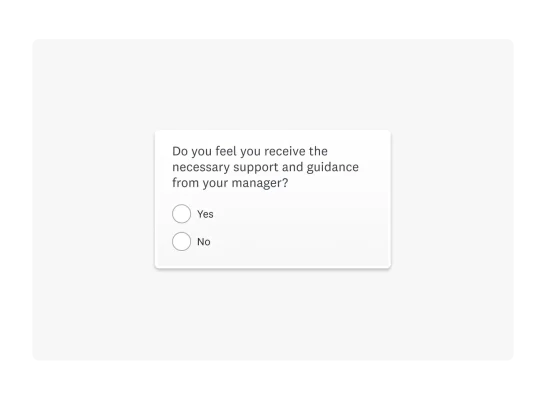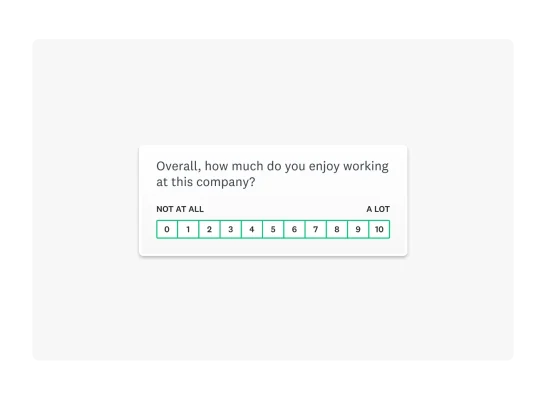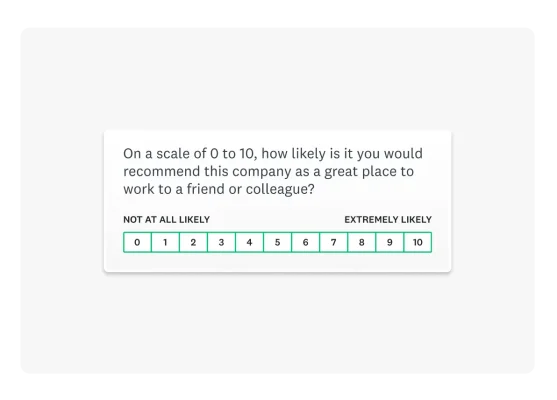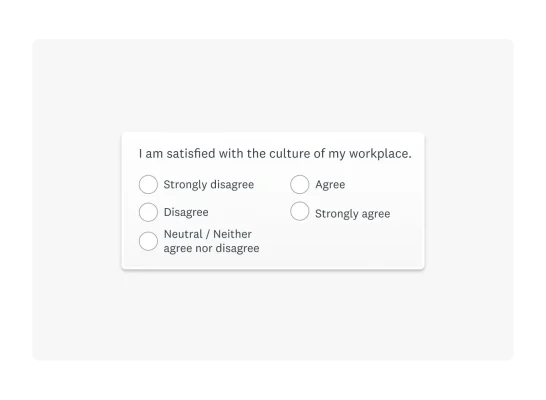24 example questions for your employee engagement surveys
Use employee engagement surveys to increase morale, retention, and productivity.

Engaged employees make the world go round. Happier employees are more productive, stay longer, and boost the bottom line.
Employee engagement surveys are a phenomenal way of measuring employee satisfaction and engagement over time. By harnessing these surveys, you can identify actionable insights that help you create a better workplace for all.
What is an employee engagement survey?
Employee engagement is the extent to which employees feel valued and involved in their everyday work. Human resources professionals and researchers debate the dimensions of employee engagement. Nonetheless, at its core, it comes down to whether employees feel invested in their company's mission and success.
The best way to measure this engagement is through a survey. Are employee engagement surveys worth it? Running an employee engagement survey doesn’t just measure employee happiness—it measures their dedication to your company's mission and outcomes.
Measuring employee engagement, then, is even more crucial. It’s an important indicator of your business's health and an excellent way to spot areas for improvement.

Ready to level up your leadership style?
Join us on Sept 30 for a virtual event to learn how to beat burnout & tackle tough calls fast
The top 24 employee engagement survey questions
So, what are good engagement questions? Effective employee engagement surveys measure feelings in six areas using a template: leadership perception, career opportunities, company culture, teamwork, job satisfaction, and work-life balance.
Use these employee engagement survey example questions to create a comprehensive survey.
Confidence in leadership and management

Gauging employee confidence in management provides insight into a company’s communication structure and leadership quality. Use these Likert scale questions to determine whether improvements are necessary.
- My supervisor, or someone at work, seems to care about me.
- I have confidence in the senior management of this organization.
- The senior management level in my organization provides clear direction and guidelines for the future.
- I receive the support I need to succeed from my manager.
Career development is an employee accelerant
Career development is a key factor in employee satisfaction and retention. A survey can uncover gaps in employee perceptions of growth opportunities. These practical example questions identify development-related gaps in your existing employee engagement program.
- In the last six months, someone at work has talked to me about my progress.
- There is someone at work who encourages my development.
- This last year, I have had opportunities at work to learn and grow.
- I receive the support I need to achieve my career goal.
Company culture and values and perception
Company culture shapes employee engagement and morale. Surveys and their results help you assess if employees are aligned with the company’s values and mission.
- The mission or purpose of my company makes me feel my job is important.
- Other staff members show a good level of positive energy.
- This organization cares about delivering a quality outcome to our customers.
- I receive appropriate recognition when I do good work.
Teamwork makes the dream work
Teamwork affects employee engagement in a big way. Best practices for employee engagement surveys require including several teamwork-related questions. These identify the effectiveness of collaboration among employees and how connected employees are to their team.
- My associates and fellow employees are committed to doing quality work.
- Information is freely shared across teams and departments.
- How skilled are the people you work with?
- I know and interact with individuals inside my department at least weekly.
Job satisfaction is good job action

Overall job satisfaction ties directly to engagement. Survey questions should help organizations understand whether employees are content with their roles. Here are some practical example questions.
- How satisfied are you with your company as a place to work?
- I like the type of work that I do.
- How valued do you feel in this organization?
- Do you feel fairly compensated for the work you do?
Work-life balance and well-being
Work-life balance is crucial for retaining employees. Businesses can measure and improve employee well-being by asking the right questions.
- My work arrangements are flexible.
- Do you feel able to maintain an appropriate and healthy balance between work and personal commitments?
- I see myself still working at [company] in two years.
- [Company] supports my out-of-office needs (parental responsibilities, mental health, education, physical health, etc.).
Why measure employee engagement?
When employees feel engaged with their work, they’re more fulfilled and more motivated. Gallup studies have long demonstrated that employee engagement influences performance, retention, productivity, and customer loyalty.
Employees with higher levels of engagement typically have a forward-thinking disposition about their company. They’ll think of ways to improve work operations, demonstrate a team-oriented mindset, and show strong leadership skills that help elevate moderately engaged employees.
With a vast range of benefits, employee engagement is vital to the success of your organization. An engaged workforce results in a more productive — and profitable — organization. We’re not talking about tiny increments here, either. The Gallup State of the Global Workplace 2024 report suggests a 23% increase in profitability for companies with highly engaged employees.
Numbers like this demonstrate that businesses benefit from measuring employee engagement and can't afford not to.
Levels of employee engagement
There are four distinct levels of employee engagement that establish a benchmark for future recurring surveys.
1. Highly engaged employees
Highly engaged employees are brand advocates and have a favorable opinion about their company. They demonstrate a strong connection with their team and perform duties outside the scope of their job responsibilities to help the company succeed. They believe in the organization's overall goals and vision.
2. Moderately engaged employees
These employees may have a general understanding of their role in their company but barely work beyond their duties and responsibilities. These employees are dependable workers with the potential to excel. However, something is usually holding them back.
3. Barely engaged employees
These are employees who are barely engaged and do the bare minimum. These employees look at their work as a task. They usually don't clearly understand how important their role is toward the company's success. Consequently, they're generally looking for other job opportunities.
4. Disengaged employees
Disengaged employees are unhappy and demonstrate no commitment to their work responsibilities. Their disconnection from their job duties, the company mission, and the company vision aids in their discontentment. They actively spread their negativity to colleagues.
Benefits of employee engagement surveys
Employee engagement is a central metric that will help you determine employee happiness. These surveys allow employees to voice concerns, ideas, and questions. By monitoring employee satisfaction over time, you can create a data-driven action plan to improve the employee experience and increase employee engagement.
Here's a list of the advantages of employee engagement surveys.
Improved employee morale
Employee engagement surveys can help you better understand how your employees feel about their job, management, and company. It shows them you care about their thoughts and that their opinions matter.
Sending out employee engagement surveys frequently tells workers you listen to them. This approach can make your employees feel valued and appreciated.
Surveys can also help you assess each person's level of employee engagement. These figures allow you to highlight high-performing employees who may have gone unnoticed.
Happier employees
Providing a platform where employees are encouraged to voice their thoughts, concerns, and opinions about their organization creates a culture of transparency where people are more comfortable. Comfortable employees are happier ones.
Employee engagement surveys also clarify communication to avoid misunderstandings and provide constructive criticism. This improves everyone’s work performance and the overall success of the organization.
Increased employee satisfaction
Employee satisfaction is directly related to employee morale.If you want to maintain high employee morale, trying to keep your employees happy is a good idea. Surveys can help you gauge employee satisfaction by asking about their jobs and future with your company.
You can learn about their feelings toward their coworkers and management and whether they'd recommend your business to others. High recommendation rates typically suggest that employees are satisfied with their jobs.
Higher employee retention rate
Ensure quality workers feel appreciated with recognition and rewards. Employees who feel valued are more likely to refrain from finding employment elsewhere.
Employee engagement surveys can help you detect employees who might be dissatisfied with their jobs. These insights empower you to implement reward incentives and team-oriented exercises that can make employees more engaged in the work culture.
Positive shift in company culture
An employee engagement survey benefits company culture by offering insight into your operations' inner workings. The feedback you receive allows you to detect pain points that may require restructuring.
Closing the feedback loop will show your employees that you’re listening to their wishes and ideas. Over time, using these surveys and responding to the feedback they generate will help contribute to a healthier, more positive company culture.
Types of employee engagement surveys
The employee experience includes everything from workplace satisfaction to contentment with job compensation. You can use various surveys to measure employee engagement effectively.
Here are the most useful types of employee engagement surveys.
Employee NPS (eNPS)

The employee Net Promoter Score® (eNPS) measures employees' overall satisfaction and engagement. This survey is straightforward, needing only one main question to begin to generate useful data.
Employees answer, “How likely is it that you would recommend working at this company to a friend or colleague?” They can answer on a scale of zero to ten, with ten being extremely likely.
You can categorize your employees into Promoters, Passives, and Detractors based on the responses. A higher proportion of promoters in your business signifies more satisfied employees.
Our Employee Net Promoter Score Survey Template enables your business to rapidly collect insights on employee engagement and satisfaction, initiating your journey to improve these metrics.
Remote work survey
Remote working has become a worldwide trend, with companies around the globe adopting remote or hybrid workplace models. Our Employee Engagement Survey Template for remote workers allows your business to monitor the engagement of these employees, no matter their location.
The survey asks questions like:
- I am satisfied with my opportunities for professional growth.
- I am pleased with the career advancement opportunities available to me.
- I am satisfied with the job-related training my organization offers.
Respondents can then select an answer that closely aligns with their opinion from a range of responses. The remote work survey enables businesses to actively monitor and enhance remote worker engagement, which boosts productivity and increases revenue.
DEI survey
A Diversity, Equity, and Inclusion survey aims to better understand the people who make up your business. These surveys will help you survey your workplace, helping to identify areas where you lack representation or where your internal practices could better align with the needs of your workforce.
Your business can use an employee diversity survey to understand the additional needs of specific individuals. You can identify what certain religious groups may need, explore further opportunities to promote inclusion, and celebrate the diversity you already have.
Businesses that emphasize the importance of diversity enjoy higher cash flow per employee and often experience higher team performance. Here are a few sample questions from an employee diversity survey:
- What is your gender identity?
- What is your sexual orientation?
- What is your racial or ethnic identity?
Employee benefits survey
One of the leading factors contributing to high employee engagement rates is great compensation packages. Your business can use an employee benefits planning survey to identify areas for enhancement.
By tracing satisfaction rates across different areas of your benefits plan, you will encounter potential improvements you can make. With these enhancements come an increased sense of satisfaction at work, higher engagement, and boosted productivity.
Here are some typical questions from an employee benefits planning survey:
- Are you currently enrolled in one of our medical benefits plans?
- Are you currently enrolled in the Health Savings Account?
- Are you currently enrolled in our vision plan?
Culture pulse surveys

Another important aspect of enhancing the employee experience is ensuring your business creates an enjoyable and supportive workplace culture. A culture pulse survey will help you measure overall workplace satisfaction, generating data on employees' feelings about workplace safety, dynamics, and compensation.
You can use culture pulse surveys to monitor if your employees are happy with the workspace you’ve created. They will also signal areas you can improve, contributing to a better workplace culture for everyone.
Wondering what questions to ask in an engagement survey? Here are a few standard questions you’ll find on a culture pulse survey:
- I am satisfied with the culture of my workplace.
- My organization has a safe work environment.
- I understand how my work impacts the organization’s business goals.
Related reading: The ultimate guide to collecting employee feedback
Employee engagement vs. employee satisfaction
What’s the difference between employee engagement and employee satisfaction? While there’s an overlap between the two, far more dimensions define employee engagement than employee satisfaction. In other words, an engaged employee is most likely satisfied, but not all satisfied employees are engaged.
A good employee engagement survey would measure the following factors.
Leadership behavior
Effective management can make or break your employee engagement. It’s not just whether your senior management treats employees well or whether they act ethically (of course, that’s important, too!).
Effective leadership at every level of the organization is crucial. That means managers who articulate company values, communicate well, and follow up with appropriate actions.
A good employee engagement survey will gauge these habits, from managers to C-level.
Nature of work
Most people don’t want an easy job. They want to be challenged and tested in their day-to-day work. Challenging work can immensely motivate employees if they see how their work relates to the company’s performance.
SurveyMonkey research from December 2023 reveals that around 90% of employees say that their work is meaningful to them. Encouraging employees to find their self-motivation and link their interests to your vision can enhance this metric.
Use your employee engagement survey to ask your employees how challenging (and motivating) their work is.
Career development
Ambitious employees are a good thing. They can be your team's most self-motivated and productive members—as long as it’s clear how you can help them advance in their careers. If it’s not, you’ll risk losing them.
Clarity around career goals is important, but you need to offer a helping hand. Are your employees getting support from educational and mentoring opportunities?
Running an employee engagement survey can help determine if your employees can see a clear path forward and have the support they need to get where they want to go.
Company pride
When employees are proud of where they work, it shows. They’re true believers in your mission and want to see your company succeed, and that attitude translates to their performance.
People who take pride in their company take pride in their work. Fostering this feeling of pride isn’t just about making employees feel good about themselves. It makes them show up to work focused, aligned with their peers, and ready to tackle problems with commitment.
Colleagues
We spend a lot of time interacting with our coworkers. In companies of every size, it’s important to consider working relationships between employees. How they interact, how they view each other’s abilities, and what they see as the strengths and weaknesses of the workforce all impact company morale.
How employees view their colleagues can greatly impact their morale and faith in meeting company goals.
Employee survey questions aimed at these issues should be a huge part of any employee engagement strategies you implement.
Boosting employee engagement with surveys
Simply measuring employee engagement isn’t enough to foster an engaged workforce. You’ve got to read the results, uncover areas for improvement, and implement employee engagement strategies to meet them.
SurveyMonkey workforce survey data shows that around 85% of workers are satisfied with their jobs. Using surveys, you can boost this average figure in your organization even more and enhance the overall employee experience.
Decide what metrics to measure
You may be interested in measuring and improving only a few employee engagement factors.
For example, you may only be interested in how human resource (HR) performance affects employee engagement in your company. In that case, you may want to use the HR Performance Survey Template or extract only the portion of the employee engagement survey template that deals with HR performance.
But if you’re truly focused on using surveys to develop employee engagement strategies, this probably isn’t the best approach. When you hone in on a specific topic from the beginning, you may miss out on other areas for improvement.
What if career development opportunities—not HR performance—are a bigger factor for employee engagement in your workforce? If you’re developing an overarching employee engagement strategy, it’s best to be comprehensive first and focus on specific parts second.
Here are some KPIs that are useful track when tracking employee engagement with surveys:
- Survey response rates: Improving response rates can help comprehensively understand your workforce.
- HR email engagement: Your HR team will likely send out employee engagement surveys. Low engagement rates with their emails could lead to unrepresentative data.
- Open-ended feedback response rates: If people skip your open-ended questions, you might not get the why behind your answers.
- Score variation between departments: Measuring employee satisfaction on a granular level will help identify potential variations between departments.
Create a plan
Whatever metrics you choose, it’s important to communicate your plan to your employees and ensure they understand how and when you’ll carry it out. Transparency is crucial to this process.
Here’s a step-by-step plan for outlining and launching an employee engagement survey scheme:
1. Write up your objectives
Create a document that clearly explains what you’re doing, why you’re doing it, and what you expect to get from it.
2. Send your plan to employees
Send your document to all your employees. In the email, make it clear that you’ll be sending out surveys to improve their experience at your company.
3. Outline the data collection
Before sending out your first survey, send an email clearly stating how you’ll be collecting data and what you’ll do with it. Be sure to outline that the survey responses will be 100% anonymous and that you value honesty from your employees.
4. Send out your first survey
Launch and send it out across all departments.
5. Collect feedback
First-hand accounts of what worked well in a survey and what didn’t will help you to develop better employee engagement surveys going forward. Always give employees the option to leave feedback that you can use to improve. Remember to close the feedback loop by responding to employees who leave their comments.
Plan for continuous improvement
How can you tell if your plan is having a positive effect? By continuously monitoring employee engagement and satisfaction and tracing any changes that occur. You're likely on the right track if your employee satisfaction rates are going up,
At first, receiving a large quantity of survey responses can be overwhelming, especially for a small business. However, a continuous culture of data will allow you to improve your employee experience over time. It’ll also display to your employees that you’re working to make your company the best possible workplace for them.
Here’s how you can review, analyze, and create data-driven insights from your survey responses:
1. Conduct data analysis
Assuming that your data is all on one centralized platform, you can use statistical analysis tools to identify patterns, trends, and potential outliers. Look for recurring themes, determine your final figures for metrics like eNPS, and highlight any discrepancies in your data.
2. Segment your employees
A further layer of data analysis you can use is audience segmentation. You can segment employees into smaller groups to see how specific departments fare regarding satisfaction. These insights will give you greater precision when making future decisions.
3. Develop action plans
Based on your results, create actionable strategies that you can follow to enhance the customer experience. For example, if your employees displayed low satisfaction with your benefits package, you should look into improving it to increase this figure. Incorporate input and feedback from your employees to find areas to improve upon.
4. Communicate your findings
Send your survey findings to your employees. Outline the metrics you’ve calculated and then describe how you’re going to improve upon them. Responding directly to feedback here can help show your employees that you care about their opinions and will work to create a better experience for them.
5. Foster continuous feedback
Improvement is never complete. Constantly survey input, respond to feedback, and survey again to generate a constant influx of new data.
Improve business operations with surveys
Measuring employee engagement with online surveys allows your business to identify actionable insights to improve satisfaction.
Build a more productive workplace using SurveyMonkey templates to increase employee engagement. Select a plan that matches your marketing strategy or sign up to get started today.
Ready to get started?
NPS, Net Promoter & Net Promoter Score are registered trademarks of Satmetrix Systems, Inc., Bain & Company and Fred Reichheld.
Discover more resources

HR toolkit: Make employee experience your competitive advantage
HR leaders can use this toolkit to help drive exceptional employee experiences.

SurveyMonkey research: 2025 Workplace Culture and Trends
Discover SurveyMonkey’s latest workplace culture trends with original data reports and employee experience research.

Help employees thrive with learning programs
Measure L&D impact with powerful survey software. Gather feedback, track growth, and improve employee development with insights that support long-term success.

C-suite secrets: Smart strategies for tough times
Hear from industry leaders on how they're facing current business challenges and driving impact